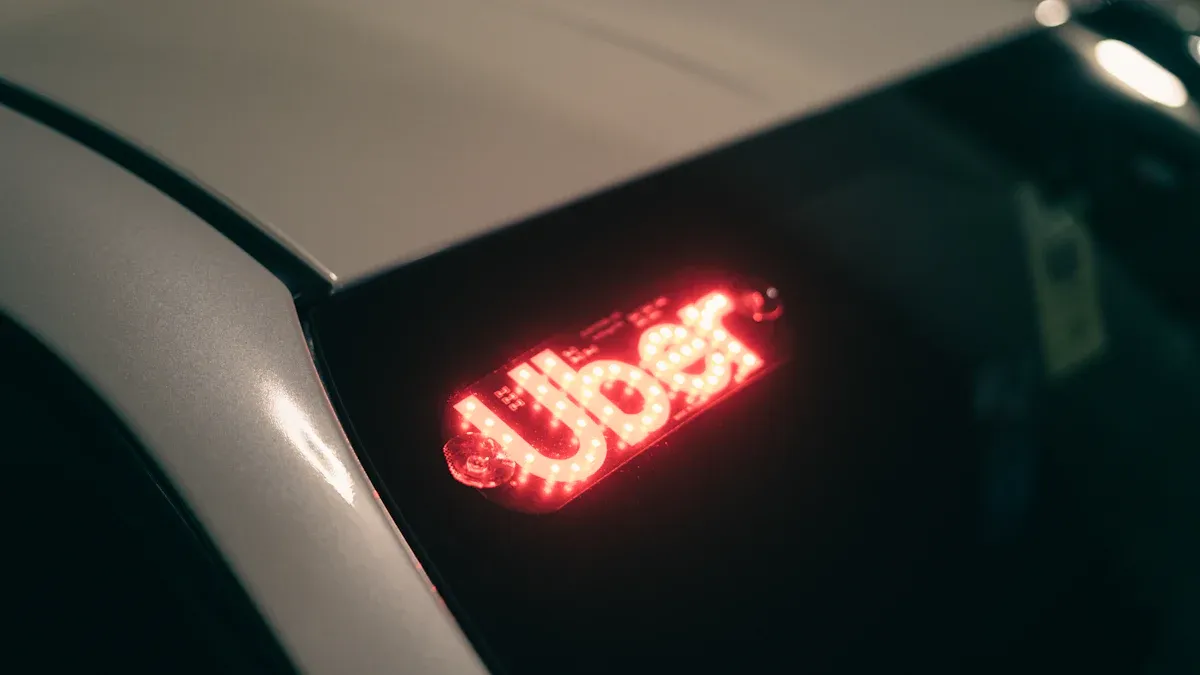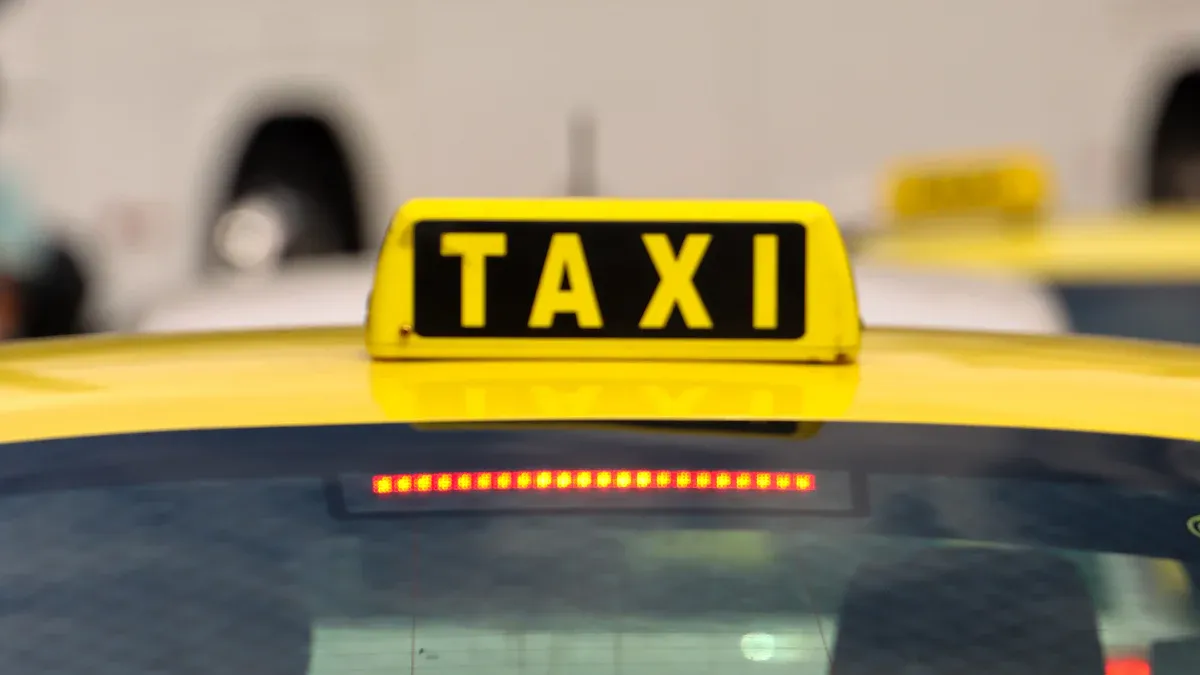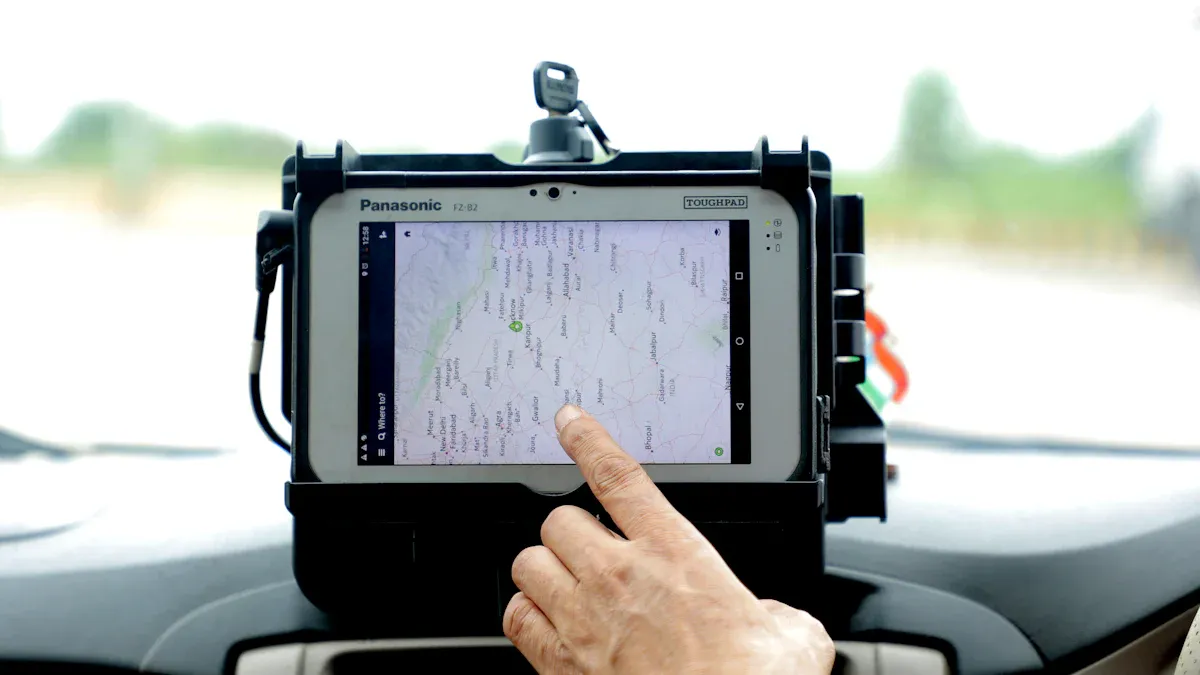
You see .ride-hailing gps ad displays when you ride in taxis or app cars. These digital screens use GPS to show ads that fit your location. This makes each ad feel more important to you. With .ride-hailing gps ad displays, advertisers reach people right away. They can do this in places where billboards cannot. This new way helps brands get noticed. It also makes people pay more attention. It changes your experience as a passenger.
Key Takeaways
GPS ad displays in ride-hailing cars show ads based on where you are. The ads change as the car moves, so they stay interesting and fit your location.
These systems have digital touchscreens inside the car. They also have LED screens on the roof. GPS and mobile networks connect them for updates right away.
Drivers can make extra money by adding these ad displays. They do not need to change how they drive. Passengers see helpful local deals and information.
The technology keeps your privacy safe by using codes, not your personal details. It also limits what drivers can know about you.
In the future, 5G and AI will help these ads get even smarter. The ads will be more personal and make your ride better.
Ride-Hailing GPS Ad Displays

What They Are
You might see .ride-hailing gps ad displays in taxis or rideshare cars. These are digital screens that show ads and info during your ride. The goal is to give you ads that match where you are and where you are going. This makes the ads feel more interesting to you.
The main parts of .ride-hailing gps ad displays work together. There is a mobile module with a phone, GPS tracker, and receiver. The system also has a sealed box, car adapter, battery, and special software. These parts help track your ride as it happens. The GPS finds your exact spot. The software uses geo-fencing to set up invisible lines on your route. This lets the system change what you see on the screens in taxis based on your location.
Tip: These screens do more than show ads. They can show your route, fare updates, and let you rate your driver.
The software can send you alerts like “Your Taxi is Here” when you get close to your pickup spot. It can also check things like fuel and engine status. This helps make the ride safer and better for everyone. The hardware and software work together to share data in real time. This helps manage all the ride-share cars at once.
Types of Displays
There are two main kinds of .ride-hailing gps ad displays in cars today:
Backseat Digital Screens (Tablet-Based Touchscreens):
The most common type is a touchscreen on the back of the front seat. These screens in taxis use Android tablets or special media players. They connect to the internet with 4G or Wi-Fi. This lets the system show ads that change with your location and ride. For example, you might see a restaurant ad when you pass a certain area.Roof-Mounted LED Screens:
Some cars have LED screens on the roof. These show ads to people outside the car. The system uses GPS to pick different ads as the car moves. This way, people on the street see the ads too.
Some cars have both types of digital signage. These use GPS to show ads inside and outside the car. The touchscreen inside can show you local deals, news, or weather. At the same time, the roof screen shows ads to people walking by.
Many uber and lyft cars use tablet touchscreens. Companies like Vugo let drivers add these screens to their cars. Drivers often buy the tablets and connect them to their phones for data. This makes it easy for drivers to join the .ride-hailing gps ad displays network and earn extra money.
Type of Display | Where You See It | Main Features |
|---|---|---|
Backseat digital screens | Inside, behind front seats | Interactive touchscreen, location-based ads |
Roof-mounted LED screens | On top of the vehicle | Visible to people outside, GPS-triggered ads |
Integrated digital touchscreens | Inside and outside | Combines both for full coverage |
These digital touchscreens make ads in cars smarter and more fun. The screens in taxis and rideshares use real-time maps and geo-fencing to show the right ad at the right time. You get ads that fit you, and advertisers reach people who are paying attention.
How They Work

Hardware and Connectivity
You will find that ride-hailing GPS ad displays use several types of hardware. The most common devices are digital touchscreen tablets, media players, and LED panels. These devices sit inside the car, often as a touchscreen on the back of the front seat, or on the roof as an LED display.
For these systems to work, they need strong network connections. Most modern screens support both Wi-Fi and 4G LTE. Here is what you might see:
9-inch LCD headrest advertising screens use Wi-Fi and 4G LTE for fast updates.
Pro and Advanced models combine 4G LTE with GPS for real-time ads and traffic updates.
Base models rely on Wi-Fi for basic content delivery.
4G and Wi-Fi connections help with live streaming, interactive touchscreen apps, and quick content changes.
Mobile DVR systems use global 4G networks and GPS for real-time video and audio.
This hardware setup lets you see ads that change as your ride moves. The digital touchscreen technology makes it easy for you to interact with the system and see new content without delay.
GPS and Real-Time Updates
GPS plays a key role in these ad displays. The system tracks your car’s exact location as you travel. When your vehicle moves into a new area, the GPS triggers the touchscreen to show different ads that match your current spot.
The updates happen very quickly. On average, the system takes about half a second to update your location and change the ad. At highway speeds, this delay means the car may move about 17 meters before the new ad appears. For city rides, this small delay does not affect your experience much. You still get ads that fit your location almost instantly.
You will notice that the touchscreen always shows content that matches where you are. This makes the ads feel more personal and timely.
Software and Content Management
The software behind these systems controls what you see on the touchscreen. Operators use remote content management tools to upload, schedule, and monitor ads from anywhere. They do not need to visit the car to change the content.
You benefit from this setup because the ads stay fresh and relevant. Operators can use Wi-Fi, 4G, or even USB to update the content. The software also lets them track which ads play and when. If there is a problem, they can fix it remotely.
GPS helps the software deliver ads based on your exact route. The system can also adjust the brightness of the screens and troubleshoot issues without anyone touching the device. This makes the whole process smooth for you and for the driver.
Note: Remote content management means you always see up-to-date ads, no matter where your ride takes you.
Ads and Targeting
Geo-Targeting
You see ads in ride-hailing cars that fit your location. GPS follows your car as you move, usually within 50 meters. This means the ads you see are about places near you. Companies use geofencing to make invisible lines on a map. When your car crosses these lines, new ads pop up. For example, you might see a coffee shop ad when you drive by one. Uber and other ride-hailing apps use this to give local deals and discounts. You get ads that match your trip and where you are, so they feel more helpful.
GPS finds your spot using satellites.
Geofencing sets up fake borders for ads.
Ads switch as you go to new places.
You see ads that fit your trip and needs.
Trip Data Use
Ride-hailing companies keep track of your trips. They know where you go, how often, and what time you ride. They use this to show ads that fit you. If you visit malls a lot, you may see ads for stores or sales. The system looks at your travel habits and favorite places. It also uses your age or other info. This helps companies send ads that feel right for you and show up at the best time.
You get ads that match what you like and do. The system checks your trip data and places you visit. This makes the ads feel more useful and less annoying.
Passenger Engagement
You pay more attention when you can use the ad screens. Many ride-hailing cars have touchscreens you can tap. These let you find fun things to do, places to eat, or ways to pay. Sometimes you get special coupons or codes during your ride. Some systems link to your phone or past searches to show ads you care about. This keeps you interested and makes the ride better.
Touchscreens give you fun and helpful info.
Personal ads make you care more and get less bored.
Coupons and deals make you notice the ads.
Good hardware makes sure the screens work well.
Note: Companies use data to make ads better and help you enjoy the ride.
Benefits and Challenges
For Drivers
You can earn extra money by adding GPS ad displays to your ride-hailing car. These screens give you a new way to make income without changing how you drive. You do not need to talk to advertisers or handle the ads yourself. The system updates ads automatically based on your location. This means you can focus on driving while the screens work in the background. Some companies even offer bonuses for drivers who use these displays often.
Tip: Many drivers find that passengers enjoy the extra information and deals shown on the screens, which can lead to better ratings.
For Passengers
You get more than just ads when you ride in a car with GPS ad displays. These screens show you local deals, news, and even community messages. The ads change as you move, so you see offers that match your location. Here are some ways these displays help you:
You see ads for shops, restaurants, or events near your route.
The screens support local non-profits and small businesses by showing their messages.
You get timely, location-based content that feels more useful.
Drivers can earn more, which can improve your ride experience.
Privacy and Safety
You may wonder how your data stays safe. Ride-hailing companies use several steps to protect your privacy:
Your real name, gender, and photo stay hidden from drivers during the ride.
The system uses random codes instead of personal details to identify you.
Only the driver’s real information is shown, not yours.
Companies use biometric checks like face or fingerprint scans to verify drivers.
Audio recording during trips helps prevent and address harassment.
Drivers only see the details needed for your ride, not extra personal info.
Note: You should check your app settings to control what data you share and clear your ride history if you want more privacy.
Technical Issues
Sometimes, GPS ad displays can have problems. You might see a screen freeze or ads that do not match your location. Weak network signals can cause delays in updating ads. Hardware like tablets or LED screens may break or need repairs. Software bugs can also affect how ads show up. Companies work to fix these issues with regular updates and remote support, but you may still notice glitches from time to time.
Business Model in Ride-Hailing Cars
Revenue Streams
Ride-hailing cars use GPS ad displays to make more money. These screens help drivers and companies earn extra cash besides normal fares. When you ride, the screens show ads that match your trip and where you are. Advertisers pay to put their ads on these screens for you and other riders to see. This gives drivers and companies a steady way to earn money. More digital ooh ads in cars are changing how companies think about ads. As more people use ride-hailing, more ads show up in cars.
Advertiser Partnerships
Advertiser partnerships decide what ads you see on the screens. Companies team up with ride-hailing apps to show ads that fit your location, time, and interests. They use smart tools like AI and GPS to pick the best ads for you. Here are some ways these partnerships work:
Advertisers use small LED or LCD screens for cool, changing ads.
Ads can update right away as your car moves to new places.
Programmatic ads match what you like and where you go.
Platforms offer banners, full-screen ads, and fun interactive deals.
Advertisers reach people who use tech and often have good jobs.
These things help advertisers show you ads that feel special and just for you.
Future Trends
GPS ad displays in ride-hailing cars are getting smarter every year. New tech like 5G, AI, and connected cars make ads more fun and accurate. Real-time data and cloud updates keep ads new and interesting. As cities get smarter, these systems will use traffic and location info to show even better ads. The market for car LED ad screens is growing fast, so you will see more personal ads and better rides. But, companies must also keep your data safe as these systems get more advanced.
You now know how GPS ad displays work in ride-hailing cars. These screens use your location to show ads that matter to you. Drivers earn extra money, and you get local deals and information. As technology grows, you may see even smarter ads in your rides.
Think about how these ads could change your travel experience in the future.
FAQ
How do GPS ad displays know which ads to show?
GPS tracks your car’s location. The system uses this data to pick ads that match where you are. You see ads for nearby stores, restaurants, or events. The ads change as you move through different areas.
Can you turn off the ad screens during your ride?
Most ride-hailing cars do not let you turn off the ad screens. Some touchscreens let you lower the volume or dim the brightness. If you want fewer ads, you can ask your driver for help.
Do these ad displays collect your personal information?
The system tracks your trip and location, not your name or contact details. Companies use codes to protect your identity. You can check your app settings to control what data you share.
What happens if the ad screen stops working?
You might see a frozen screen or blank display. The company can fix many problems remotely. Sometimes, the driver may need to restart the device. If the screen does not work, your ride continues as normal.
See Also
Best Motorcycle GPS Units Supporting CarPlay And Android Auto
Understanding Wireless CarPlay Adapters And Their Driving Benefits
Top Wireless Adapters For CarPlay And Android Auto Now
